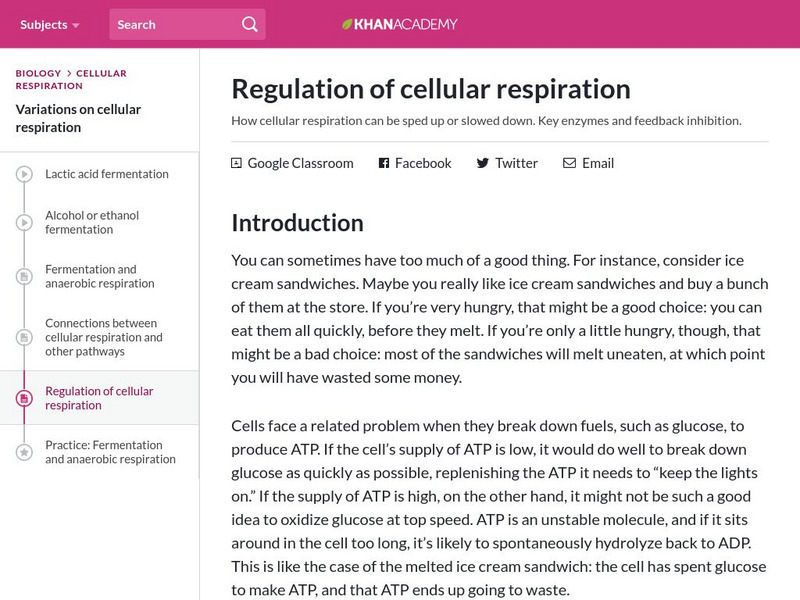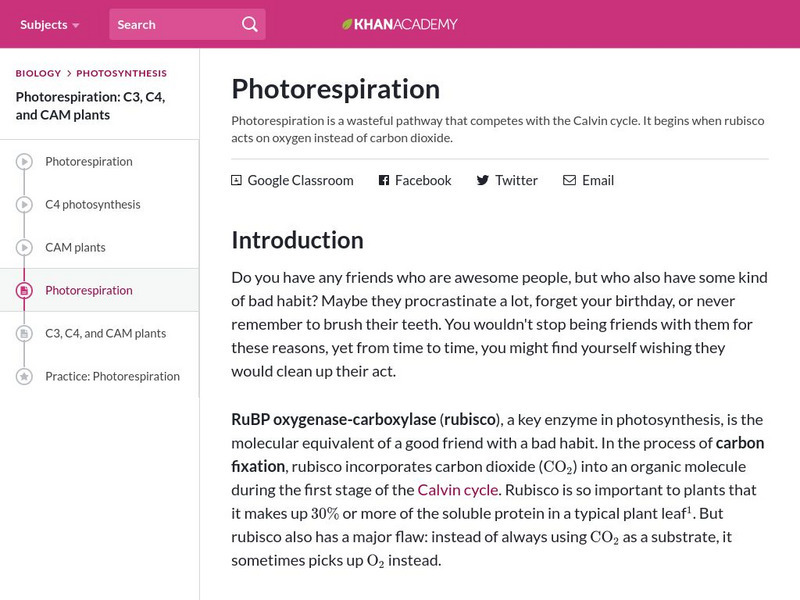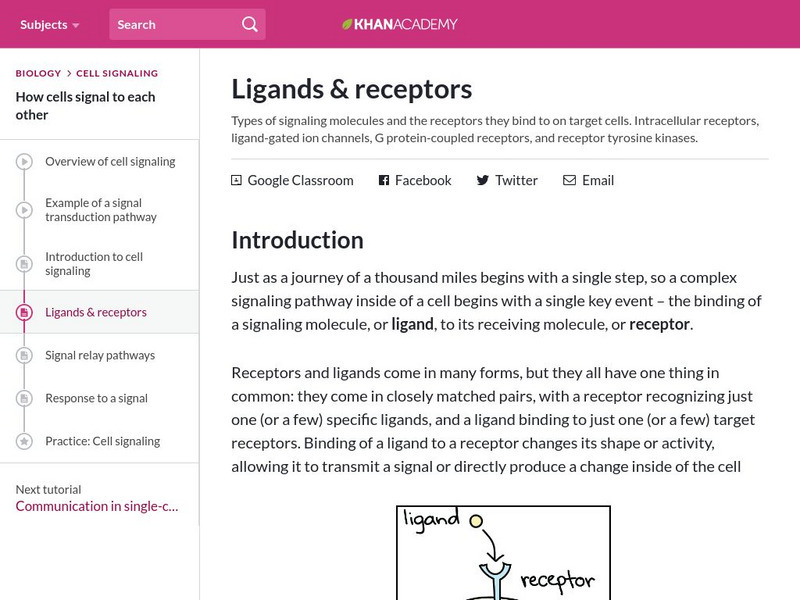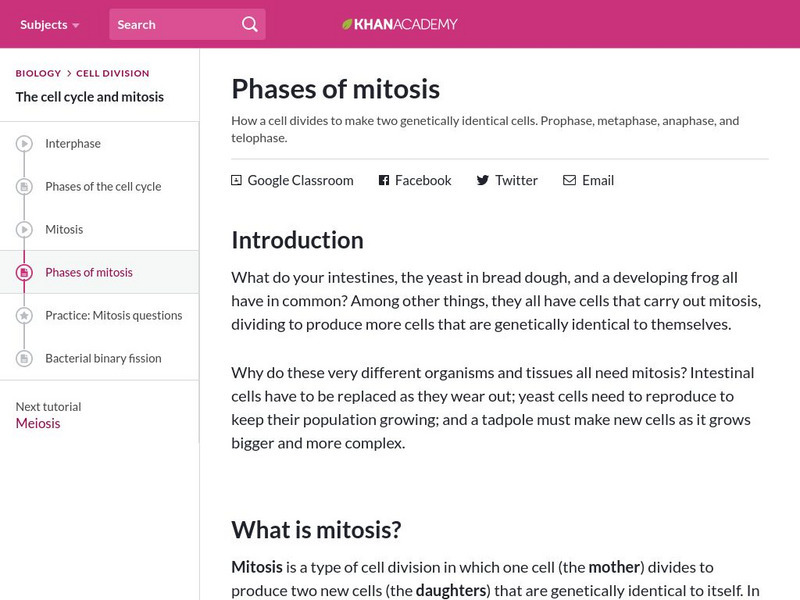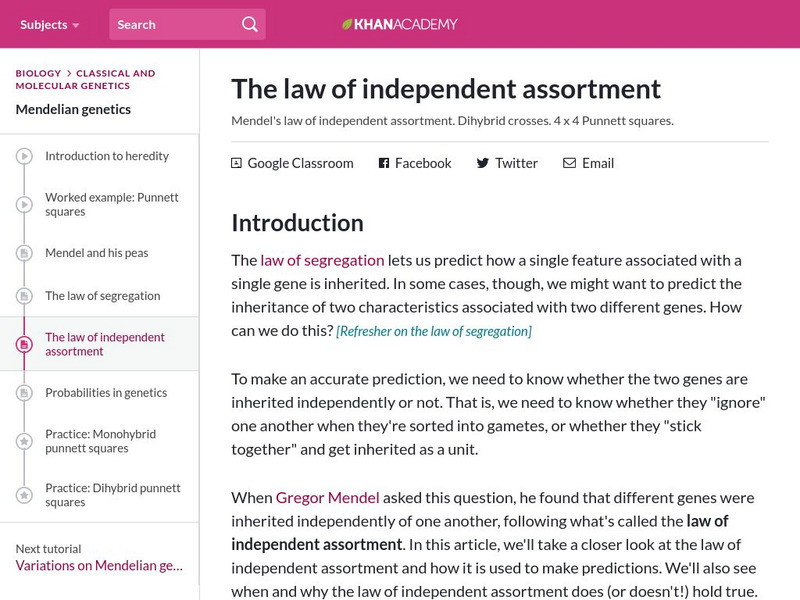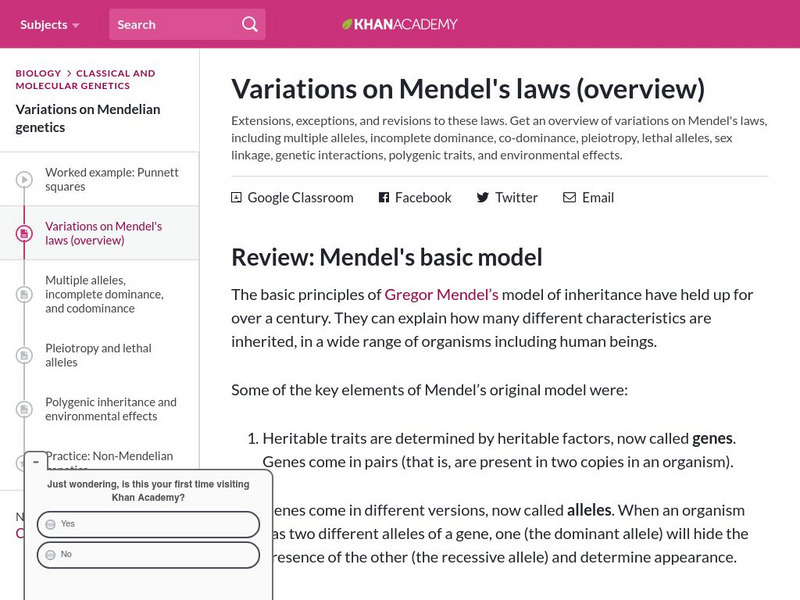Khan Academy
Khan Academy: Regulation of Cellular Respiration
This article investigates how cellular respiration can be sped up or slowed down in response to ATP levels and other metabolic signals.
Khan Academy
Khan Academy: Light and Photosynthetic Pigments
What is light energy? Here we'll learn about the properties of light and how pigments such as chlorophylls absorb light energy.
Khan Academy
Khan Academy: The Light Dependent Reactions
Article explores the light-dependent reactions as they take place during photosynthesis in plants. Traces how light energy is used to make ATP and NADPH and explains photosystems and electron transport chains.
Khan Academy
Khan Academy: The Calvin Cycle
Learn about the three stages of the Calvin Cycle reactions: carbon fixation, reduction, and regeneration of the starting molecule. See how the products of the light reactions, ATP and NADPH, are used to fix carbon into sugars in this cycle.
Khan Academy
Khan Academy: Photorespiration
Photorespiration is a wasteful pathway that competes with the Calvin cycle. Explore why photorespiration happens, when it's most likely to take place, and how it actually works.
Khan Academy
Khan Academy: C3, C4, and Cam Plants
Article takes a close look at how the C4 and CAM pathways help reduce photorespiration.
Khan Academy
Khan Academy: Introduction to Cell Signaling
This article examines the basic principles of how cells communicate with one another using different kinds of short- and long-range signaling.
Khan Academy
Khan Academy: Ligands & Receptors
Article looks at different types of receptors and ligands, seeing how they interact to turn information from outside the cell into a change inside the cell.
Khan Academy
Khan Academy: Signal Relay Pathways
Learn how signals are relayed inside a cell starting from the cell membrane receptor. Look at the general characteristics of intracellular signal transduction pathways, as well as some relay mechanisms commonly used in these pathways.
Khan Academy
Khan Academy: Response to a Signal
Article takes a look at examples of the different ways cells can change their behavior in response to a signal at both the "micro" and "macro" levels.
Khan Academy
Khan Academy: Cell Cell Signaling in Unicellular Organisms
Article takes a look at how unicellular organisms "chat" with one another using chemical signals. It examines yeast mating types, bacterial quorum sensing, and biofilms.
Khan Academy
Khan Academy: Chromosomes
This informative resource features an overview of genetic material: DNA, chromosomes, genomes, homologous chromosomes, sister chromatids, and haploid/diploid.
Khan Academy
Khan Academy: Phases of the Cell Cycle
Article explores the life cycle of a cell and delves into the phases of the cell cycle.
Khan Academy
Khan Academy: Phases of Mitosis
Tutorial examines how a cell divides to make two genetically identical cells and explores the four basic phases: prophase, metaphase, anaphase, and telophase.
Khan Academy
Khan Academy: Cell Cycle Checkpoints
Learn how cells use checkpoints to regulate the cell cycle. This article provides an overview of cell cycle control, outlining the factors that influence a cell's decision to pause or progress at each checkpoint.
Khan Academy
Khan Academy: Cell Cycle Regulators
This article looks at a few of the most important core cell cycle regulators: proteins called cyclins, enzymes called Cdks, and an enzyme complex called the APC/C.
Khan Academy
Khan Academy: Cancer and the Cell Cycle
Article takes a look at how cancer develops and what's wrong with cancer cells. Also, delves into how abnormal forms of cell cycle regulators can contribute to cancer.
Khan Academy
Khan Academy: Apoptosis
Resource explains apoptosis (programmed cell death) and how it is different from necrosis (cell death due to injury).
Khan Academy
Khan Academy: Mendel and His Peas
Discover how Gregor Mendel uncovered the key principles of inheritance using a simple, familiar system: the pea plant. Learn about Mendel's life, his experiments, and his legacy.
Khan Academy
Khan Academy: The Law of Segregation
Resource provides a discussion of Mendel's law of segregation with a focus on genotype, phenotype, alleles, heterozygous/homozygous, and 2 x 2 Punnett squares.
Khan Academy
Khan Academy: The Law of Independent Assortment
Article defines Mendel's law of independent assortment, provides examples, and takes a look at how it is used to make predictions. Also, discusses dihybrid crosses and 4 x 4 Punnett squares.
Khan Academy
Khan Academy: Probabilities in Genetics
Article reviews some probability basics then investigates how these calculations can be applied to genetics problems involving relatively large numbers of genes. Explores how the sum rule and the product rule can be used to solve these...
Khan Academy
Khan Academy: Variations on Mendel's Laws (Overview)
Article reviews Mendel's basic model of inheritance then provides an overview of variations on Mendel's laws, including multiple alleles, incomplete dominance, co-dominance, pleiotropy, lethal alleles, sex linkage, genetic interactions,...
Khan Academy
Khan Academy: Multiple Alleles, Incomplete Dominance, and Codominance
In the real world, genes often come in many versions (alleles). Alleles aren't always fully dominant or recessive to one another, but may instead display codominance or incomplete dominance.
